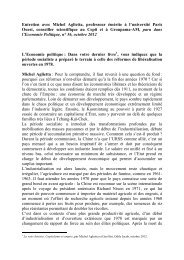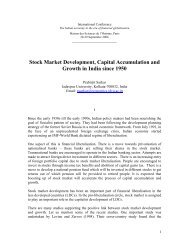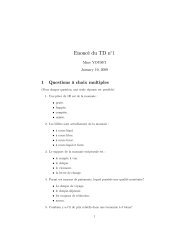Does the Entry Mode of Foreign Banks Matter for Bank ... - EconomiX
Does the Entry Mode of Foreign Banks Matter for Bank ... - EconomiX
Does the Entry Mode of Foreign Banks Matter for Bank ... - EconomiX
You also want an ePaper? Increase the reach of your titles
YUMPU automatically turns print PDFs into web optimized ePapers that Google loves.
have steadily increased <strong>the</strong>ir market share in household deposits from 1.1% in 1993 to41.5% in 1999, and in household credits from 0.7% in 1993 to 34.8% in 1999.O<strong>the</strong>r activities which complement core corporate services are non-financialservices such as consulting, security trading and leasing. These allow banks to use <strong>the</strong>irknow-how and liquid resources to earn some extra income. However, as <strong>the</strong>re are anumber <strong>of</strong> specialized non-bank institutions in <strong>the</strong>se areas <strong>of</strong> activity, <strong>the</strong>y are treated as`windows <strong>of</strong> opportunity’ ra<strong>the</strong>r than directions in which banks should concentrate <strong>the</strong>irresources and ef<strong>for</strong>ts (Konopielko, 1999).In <strong>the</strong> Czech Republic, in terms <strong>of</strong> asset structure, <strong>the</strong> shares <strong>of</strong> credits and <strong>of</strong>tradable securities in <strong>for</strong>eign banks' balance sheet are generally lower than in largedomestic banks. On <strong>the</strong> liabilities side, <strong>for</strong>eign banks depend heavily on interbankmarkets, having a much lower level <strong>of</strong> clients’ deposits in <strong>the</strong>ir portfolios. Thisunderlines <strong>the</strong> corporate-oriented approach <strong>of</strong> <strong>for</strong>eign banks.In Poland, <strong>for</strong>eign banks engage around 40% <strong>of</strong> <strong>the</strong>ir assets in interbankoperations and trade finance. However, most <strong>of</strong> <strong>the</strong> <strong>for</strong>eign banks also depend heavily on<strong>the</strong> interbank market. Deposits in financial institutions averaged 10.6% <strong>of</strong> assets, while<strong>for</strong> 100% owned <strong>for</strong>eign banks <strong>the</strong> corresponding ratio amounted to 32.8%. Most <strong>of</strong> <strong>the</strong><strong>for</strong>eign banks have already established or are due to establish <strong>the</strong>ir own brokerage firms.Ano<strong>the</strong>r notable distinction <strong>of</strong> <strong>for</strong>eign banks is <strong>the</strong>ir low level <strong>of</strong> fixed assets in total assetvolume. This is caused by <strong>the</strong> low number <strong>of</strong> branches <strong>of</strong> <strong>the</strong>se banks outside Warsaw. Inmost cases, banks’ premises are rented and <strong>the</strong>re<strong>for</strong>e contribute to operating costs. Somebanks (Creditanstalt, ING and LG Petrobank) recently engaged in <strong>the</strong> development <strong>of</strong>headquarters buildings which in future might lead to an increase <strong>of</strong> fixed assets/totalassets ratio and a decrease in operating costs (Konopielko, 1999).3. Research Hypo<strong>the</strong>ses3.1 Per<strong>for</strong>mance Comparisons Across Categories <strong>of</strong> <strong><strong>Bank</strong>s</strong>So far, most <strong>of</strong> <strong>the</strong> literature on <strong>the</strong> role <strong>of</strong> <strong>for</strong>eign ownership on bank per<strong>for</strong>mance hasarrived at <strong>the</strong> following main conclusion: <strong>for</strong>eign banks outper<strong>for</strong>m <strong>the</strong>ir domestic peers.Based on this result, we <strong>for</strong>mulate <strong>the</strong> following hypo<strong>the</strong>sis 1.Hypo<strong>the</strong>sis 1: <strong>Foreign</strong> banks are more efficient than domestic banks.-15-




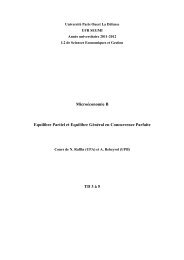

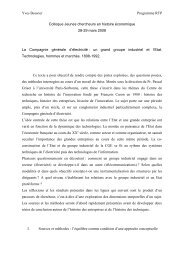

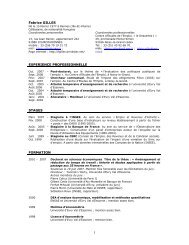
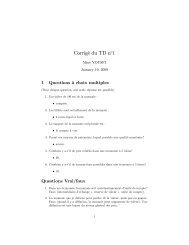
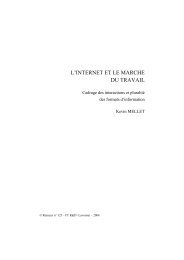
![P * 1 JTZWL_TZY OP^ Sd[Z_Sl^P^ !=m_m]Z^NmOL ... - EconomiX](https://img.yumpu.com/42226403/1/190x143/p-1-jtzwl-tzy-op-sdz-slp-m-mznmol-economix.jpg?quality=85)
